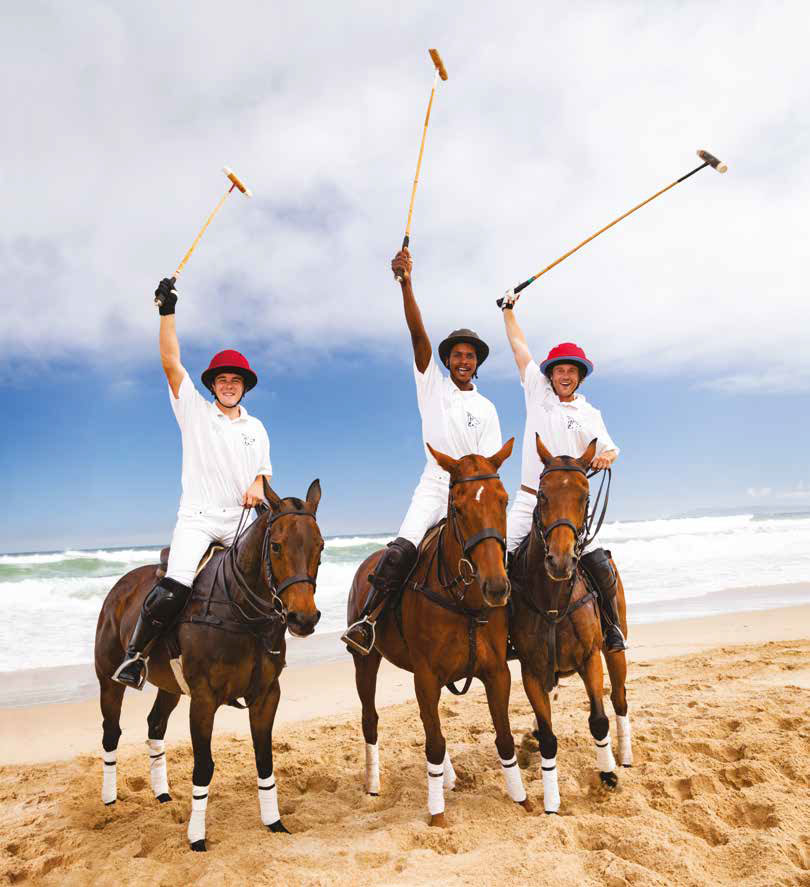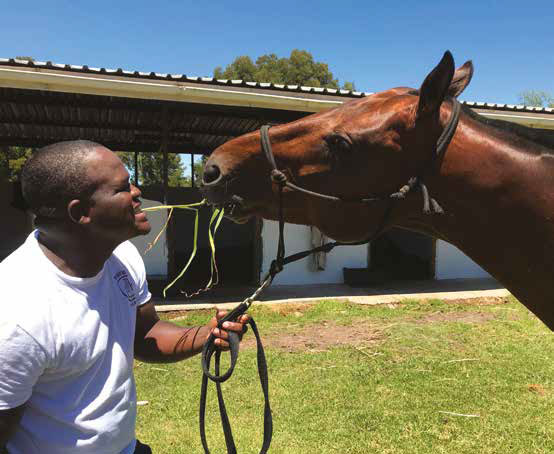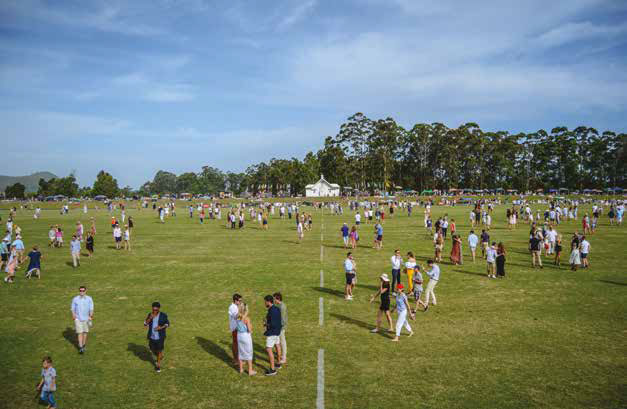
With one polo field the size of five rugby fields, spectators might be at the wrong end of all the action, but no sooner do you think that, than turf is flying in front of you from horses galloping at up to 50km per hour downfield. Lund points out that a good match sees up to about 10 or 11 goals scored at each end in one match, so there’s never a dull moment!
If you haven’t experienced the thrill of watching this sport, it’s time to give it a go! Garth Kanigowski, a player and spokesperson of Plett Polo Club, encourages people to come along to matches at Kurland, “straight off the beach in your boardshorts, if that’s what makes you feel comfortable.” He says you can’t tell who’s a CEO of big business from anyone else at a polo match, because they are just as likely to turn up in a faded old T-shirt and slipslops as anyone else! It’s the Plett vibe!
But I’ll be getting dressed up when I head to the Plett Polo Festival at Kurland on the 29th December 2019, for Plettenberg Bay’s biggest polo day of the year, ‘the international’. Players and horses come from all over the world to compete in this prestigious event, and over the polo season, Plett accommodates about 200 visiting players from Africa and abroad. There are numerous matches leading up to the International, starting in the second week in December, right through to mid-January, then the Estate Agents Cup on 8 March and the Ladies African Open from 20-22 March, then games daily until the end of the month.

LADIES ARE TAKING POLO BY STORM
If you thought polo was a sport just for well-heeled men, you’d be wrong! Ladies’ polo is the fastest growing sector, playing in teams alongside men or in ladies-only tournaments. Doug Lund says, “ladies have less brute force and more finesse, which seems to get the best out of their ponies.” Tessa Moxon is resident at the Kurland Estate polo yard, bringing on her 6 polo ponies ready to compete in January and March. “Lots of training, not many matches!” she says with a wry grin. She explained that UK ladies’ polo players are considered the best in the world, and some will be coming to compete at Kurland in March.
Argentina produces the best male polo players and topping the list as the world’s best is Facundo Pieres. He’s been winning tournaments on a South African bred horse called Abundance. It’s a bitter-sweet pill for player Shaun Brokensha, who trained the mare at his Bay Polo yard in Plettenberg Bay, then exported her to England to reach her potential. Shaun still has her foal and her brother, not yet in training, so the champion thoroughbred bloodline continues.
FOR THE LOVE OF THE HORSE
Most South African polo ponies are thoroughbred exracehorses and more often than not mares. Rider and trainer Buster MacKenzie says it’s because, “mares are more gutsy than geldings.” For the uninitiated, a gelding is a castrated male horse. There are not many stallion polo ponies, as they get too heavy in the neck (and not as I thought, because they might get too lascivious with the mares – they are apparently too busy galloping up- and downfield for that!).
There’s a belief in the horsey world that chestnut mares should be avoided, so when I wandered through the Bay Polo paddocks with Shaun’s wife Alicia – the polo manager for Plett Polo Club – and saw a preponderance of chestnut mares, I raised the topic. “Ha ha,” she laughed, “it’s true they are temperamental, but we love them anyway!”
It’s the absolute love of the horse that drives every rider and owner and I’ve never come across more devotion to horses than in the polo fraternity. Chris Taombe, stable manager at Bay Polo, laughs when he says, “Polo ponies are treated like gold!”
Chris travels the world with Shaun Brokensha – one of South Africa’s top players – and rose from groom to head groom to stable manager. He lives his dream of regularly travelling to England with Shaun but was at first horrified by the weather. “The cold and rain were a terrible shock for a Zulu from KwaMashu!”
Chris loves horses, ergo he loves his job. “My life is more than good, and my future is bright, as long as I’m still doing this.” He’s one of the richest men in his KZN village, judging by the 48 Nguni cows he owns. He’s aiming to increase his herd to 100, but at R15,000 each, he’s got some work to do. He also wants to buy a tractor to plant maize to feed his village, but that costs the equivalent of 35 cows. Another groom has chosen to invest in taxis, but Chris is a livestock man.
Chris rides well and is involved in training the polo ponies but doesn’t play in matches. However, another groom at Bay Polo, also from KZN is Sakhila Letula, who has proven his ability on the field and took part in his first tournament this year. He instantly improved his handicap and will play some games at Kurland in December. With ambition to reach the same handicap as South Africa’s top players, Sakhila is a player to watch!
HOW THE HANDICAP WORKS
The handicap system works opposite to golf, and the lowest ranking player is rated at (minus) -1 goals, and the highest ranking is 10 goals. Goal handicaps are reviewed twice a year and players are deemed good enough to turn professional at 2 goals. It’s no surprise that all of the 10 goal players in the world today are from Argentina. Facundo Pieres is one of the nine or ten current players to have reached this revered status. Shaun Brokensha is a creditable 4 goals, as is Buster MacKenzie (although in more youthful years was a 6), while Buster’s son Chris is a laudable 7 and plays all around the world. There’s never been a 10 in South Africa…yet!
Buster MacKenzie is owner of Kurland Park polo farm and has been a big part of polo in Plett as a trainer and rider, with 48 stables, a practice and playing field, grazing paddocks and guest house accommodation for visiting polo players, trainees and their families and tourists. His love of horses is palpable, and he takes three years to train a horse off the race track ready for the polo field. Racehorses have been taught to go very fast in a straight line and he has to “naturalise” them, with many months off, just grazing the paddocks to relax.
Then the patient training begins, turning a resolute racehorse into a nimble polo pony, with hours of slow flatwork, suppling, balancing and bending, with soft contact on the bit. By the end the ponies can run, wait, stop and turn at any given moment, with the lightest of commands. At 54 years old Buster admits, “I may have to stop competing one of these days, but I’ll never give up training. I love bringing on young horses and teaching aspiring young players.”
Buster has been involved with kids’ polo for 20 years and Hurlingham Polo Association in the UK sends 10-15 players to him each year for short, intense training.
A MINK AND MANURE SPORT
Gorgeous Garth Kanigowski tried to convince me that polo isn’t an elitist sport, which clearly it is! If he had tried to persuade me that not all polo players are good-looking, he wouldn’t have succeeded either. And the horses are beautiful too! Perhaps with each of the 6 chukkas per match now shortened to 5 minutes each (instead of the more taxing for the horse 7 minutes), an amateur rider could get away with owning only 3 or 4 horses. But no professional polo player has less than 10 ponies each. It’s a rich man’s sport.

What Garth did convincingly point out, was that the Plettenberg Bay polo scene benefits the local economy to a tune of R35-40 million annually, through accommodation, restaurants, travel, tourism, stabling, training, vets, farriers and horse feed. That’s a massive economic boost to the area and with Plett Polo Club as the driving force to increase the popularity of polo, the prospects are good. More polo is played in Plettenberg Bay than anywhere else on the African continent. We have Kurland Estate to thank for that, putting Plett on the map as the epicentre of South African polo.
There may be 10 or 11 polo yards in Plett, but Kurland is where the main action happens, with a splendid white pavilion overlooking the immaculately turfed match field. While non-guests of 5-star Kurland Hotel are welcome for afternoon tea, sundowner drinks or supper, you might not find a spot if you drop in during the summer tourist and polo season. Nothing like the original woodcutters cottage Peter Behr’s grandfather built on this site, Kurland Hotel exudes grandeur in an acceptably faded manor.
The whole of Kurland is a family affair, run by Peter Behr and owned by his brother-in-law and loyal polo supporter Clifford Elphick. Polo family dynasties spawn children who follow in the footsteps – or should I say saddles – of their polo-playing mothers or fathers. In Plett that aligns with surnames like MacKenzie, Brokensha, Lund, Robertson, Kanigowski, Crow, and Richardson. If your surname doesn’t appear, and you don’t even know how to ride, or have the flashy cash to own a string of polo ponies, that doesn’t prohibit you from enjoying a brilliant day out watching this enthralling sport.
Sitting on the grassy banks surrounding the polo fields is free, so pack a picnic and head on down to Kurland this summer. Whether you do so in a posh frock or ripped shorts is just fine, because as you know, anything goes in Plett!
Match fixtures can be found here www.plettpolo.co.za
The author Carrie Hampton, wishes to thank to all the people mentioned in the article for their generous assistance and for Kurland Hotel for exquisite accommodation. You can find Carrie on safaritart.com












